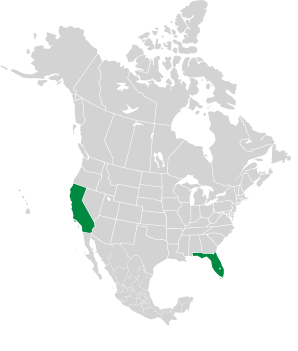Mesembryanthemum edule L.

|
Carpobrotus edulis (L.) L. Bolus Ice plant, hottentot fig, highway ice plant, pigface, sour fig
I couldn't find an explanation for the common name, "ice plants." It certainly isn't related to their preferred climate, which is hot and dry. Ice plants are succulents—plants that cope with arid regions by storing water in thick leaves. Ice plants are native to South Africa. They were introduced into North America, where they thrived and are classified as invasive species in many habitats. Identification: Plants form large, low-growing mats less than 5″ (13 cm) high. Leaves are about 2-4′ (60-130 cm) long, and triangular in cross-section, with each edge about ⅜-7/16″ (1-1.2 cm) long. Flowers are yellow or light pink and 2½-6″ (6.3-15 cm) in diameter. Don't confuse these with Carpobrotus chilensis: |
7/29/2023 · South Africa · By Benjamin Winslow |
||||||||||||||||||||||||||||
|
| |||||||||||||||||||||||||||||
Carpobrotus chilensis |
You are here Carpobrotus edulis |
||||||||||||||||||||||||||||
|---|---|---|---|---|---|---|---|---|---|---|---|---|---|---|---|---|---|---|---|---|---|---|---|---|---|---|---|---|---|
| Common Name |  |
 |
|||||||||||||||||||||||||||
| Plant | A few inches high, with stems that creep along the ground, spreading quickly. | 3-4″ (7.6-10 cm) high, with stems that creep along the ground, spreading quickly. | |||||||||||||||||||||||||||
| Flowers | Dark pink or purple. Larger, 1½-2½″ (3.8-6.3 cm) in diameter. | Smaller, 2½-6″ (6.3-15 cm) in diameter, yellow or light pink. | |||||||||||||||||||||||||||
| Leaves | Triangular cross section, 1½″ (3.8 cm) long | Up to 5″ (13 cm) long, dense, triangular in cross-section. Green or yellow-green leaves may be tinged with red. | |||||||||||||||||||||||||||
| Fruit | Green to yellowish, roughly oval | About 1½″ (3.8 cm) in diameter, shaped like a spinning top. | |||||||||||||||||||||||||||
| Range/ Zones |
|
|
|||||||||||||||||||||||||||
| Habitats | Coastal sage scrub | Coastal sage scrub | |||||||||||||||||||||||||||
| Type | Wild | Wild | |||||||||||||||||||||||||||
| Occurrence | Common, fairly invasive | Invasive in California, Australia, and the Mediterranean | |||||||||||||||||||||||||||
By Barry Rice at sarracenia.com. 
Edibility: Fully ripe fruit can be made into pickles, chutney, etc. Leaves are edible, used in salads or as a substitute for pickled cucumber, though some don't like the sticky nature of the interior (like okra).
Online References:
The South African National Biodiversity Institute's web site, plantzafrica.com
Plants for a Future, a resource and information centre for edible and otherwise useful plants
The University of Florida Institute of Food and Agricultural Sciences
The California Invasive Plant Council
The Global Invasive Species Database
Mesembryanthemum edule L.
Carpobrotus edulis description by Thomas H. Kent, last updated 16 Sep 2020.
© FloraFinder.org. All rights reserved.
3/20/2011 · By Benjamin Winslow 
8/9/2023 · Cape of Good Hope, Western Cape, South Africa · By Benjamin Winslow 
Range: Zones 9-11:
